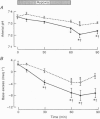Abstract
1. In seven unanaesthetized fetal sheep (> 80% term), isocapnic hypoxia (arterial partial pressure of O2, Pa,O2, approximately 15 mmHg) was induced for 1 h by lowering maternal inspired PO2. Fetal hypoxia was also produced during intra-arterial administration of the adenosine receptor antagonist 8-(p-sulphophenyl)-theophylline (8-SPT). The fetal 8-SPT infusion was begun just prior to hypoxia and was stopped when fetal Pa,O2 was returned to normal. 2. Hypoxia induced a progressive fetal acidosis, a rise in mean arterial pressure, a transient fall in heart rate and a decrease in breathing movements. 8-SPT significantly reduced the metabolic acidosis and abolished the hypertension and bradycardia without altering hypoxic inhibition of fetal breathing. Administration of the vehicle for 8-SPT during hypoxia did not significantly affect the normal fetal metabolic and cardiovascular responses to acute O2 deprivation. 3. It is concluded that adenosine mediates the fetal bradycardia and hypertension produced by hypoxia, indicating that adenosine modulates fetal autonomic responses to acute oxygen deficiency. Secondly, adenosine contributes to fetal metabolic acidaemia, suggesting that adenosine also modulates fetal glycolytic responses to hypoxia.
Full text
PDF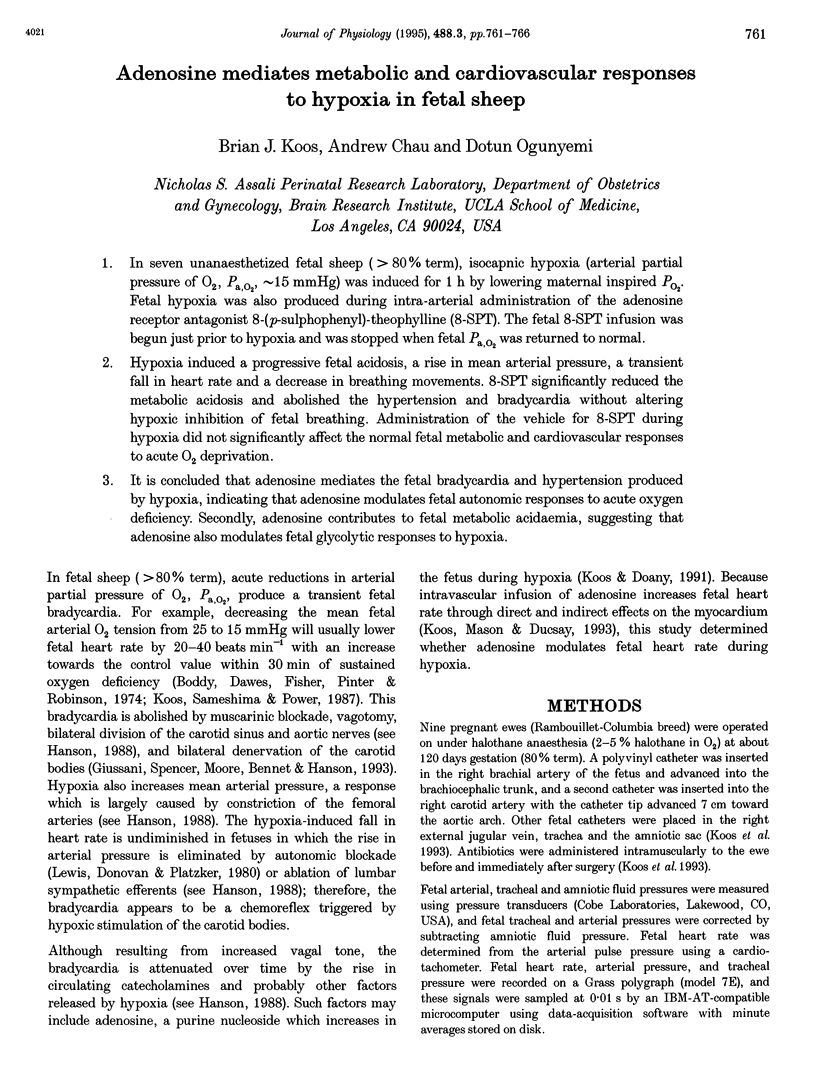
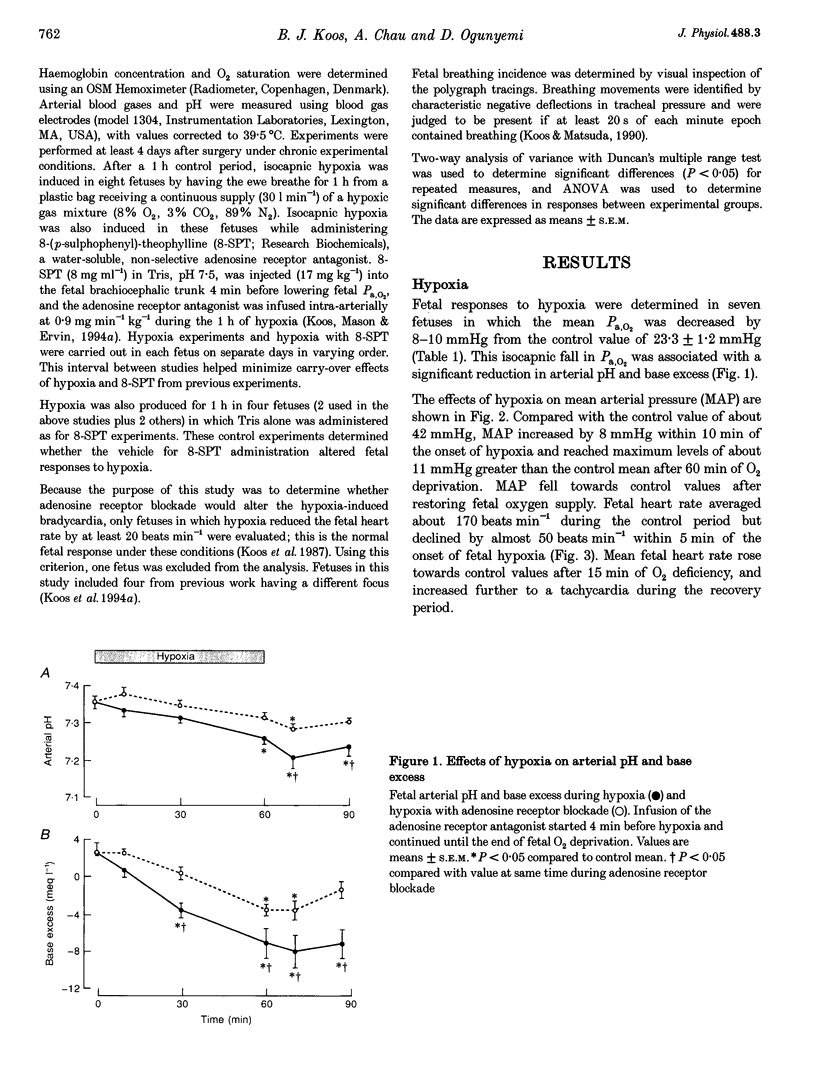
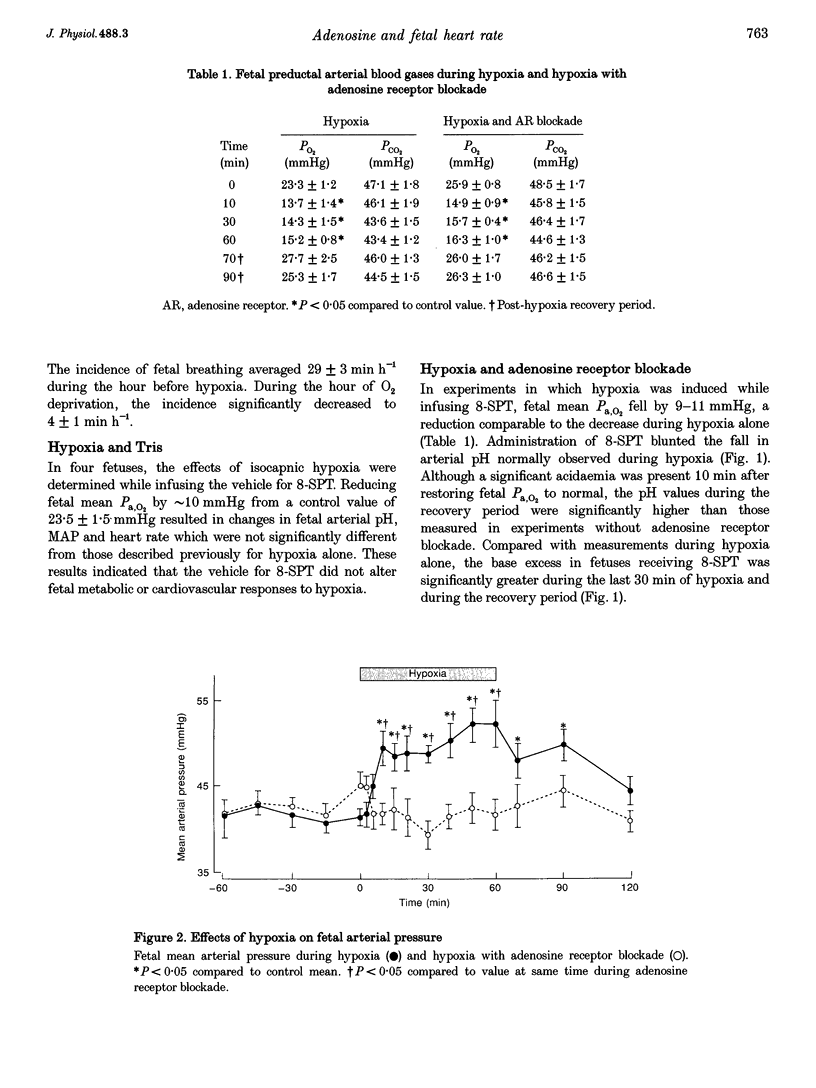
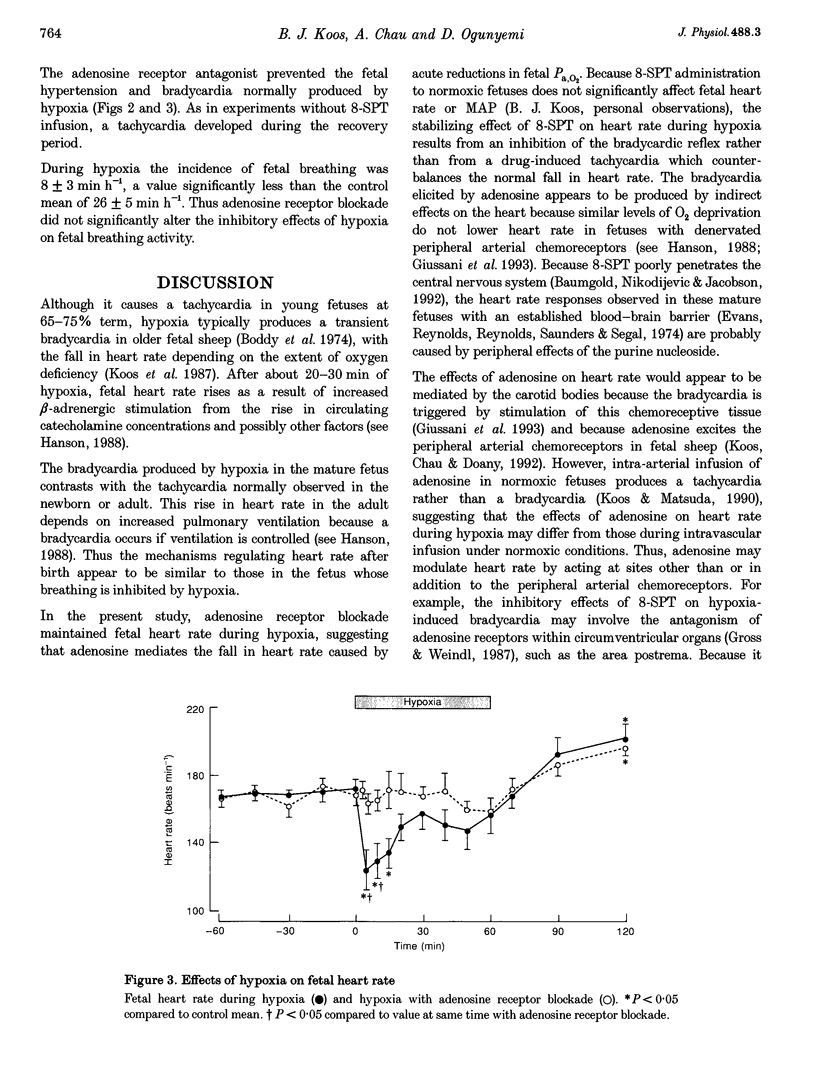
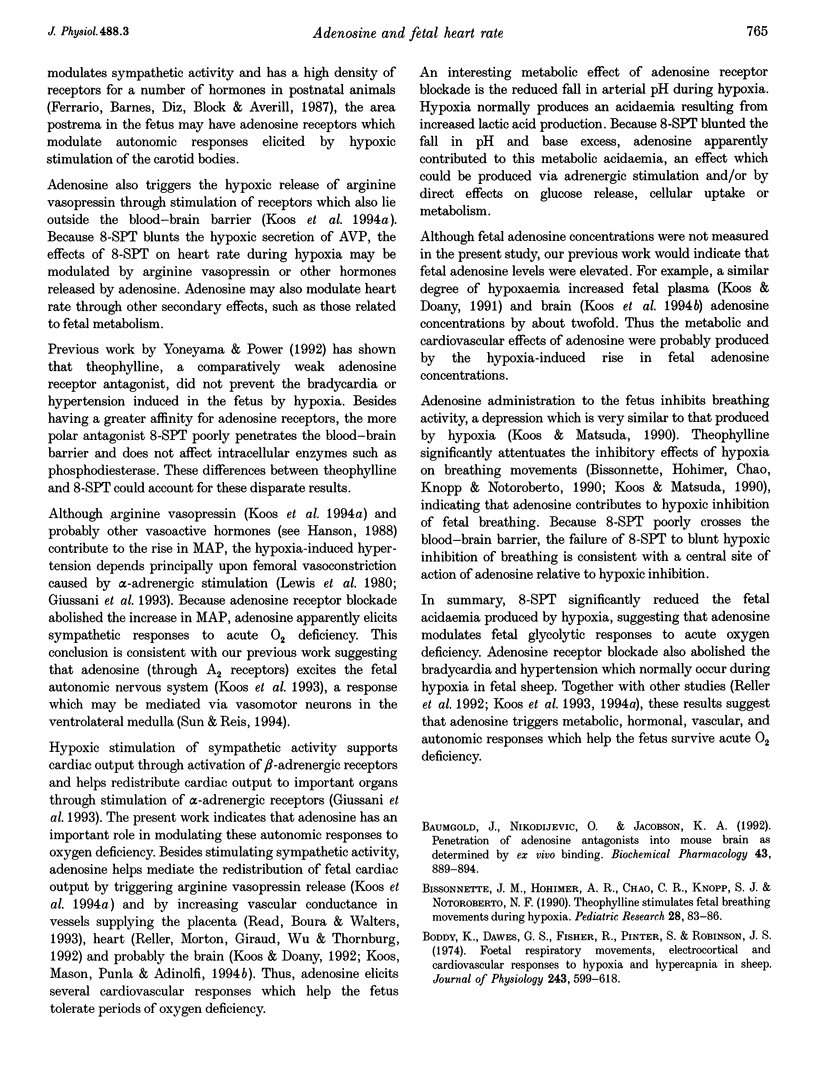
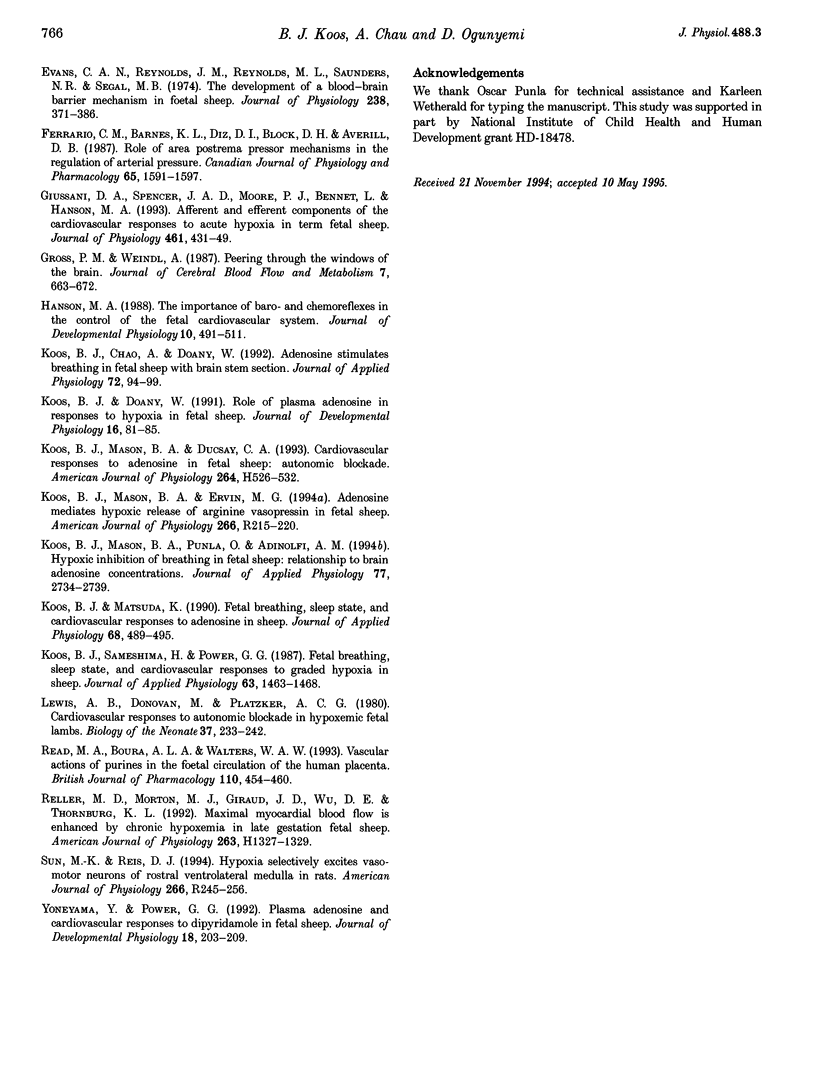
Images in this article
Selected References
These references are in PubMed. This may not be the complete list of references from this article.
- Baumgold J., Nikodijevic O., Jacobson K. A. Penetration of adenosine antagonists into mouse brain as determined by ex vivo binding. Biochem Pharmacol. 1992 Feb 18;43(4):889–894. doi: 10.1016/0006-2952(92)90257-j. [DOI] [PMC free article] [PubMed] [Google Scholar]
- Bissonnette J. M., Hohimer A. R., Chao C. R., Knopp S. J., Notoroberto N. F. Theophylline stimulates fetal breathing movements during hypoxia. Pediatr Res. 1990 Aug;28(2):83–86. doi: 10.1203/00006450-199008000-00002. [DOI] [PubMed] [Google Scholar]
- Boddy K., Dawes G. S., Fisher R., Pinter S., Robinson J. S. Foetal respiratory movements, electrocortical and cardiovascular responses to hypoxaemia and hypercapnia in sheep. J Physiol. 1974 Dec;243(3):599–618. doi: 10.1113/jphysiol.1974.sp010768. [DOI] [PMC free article] [PubMed] [Google Scholar]
- Evans C. A., Reynolds J. M., Reynolds M. L., Saunders N. R., Segal M. B. The development of a blood-brain barrier mechanism in foetal sheep. J Physiol. 1974 Apr;238(2):371–386. doi: 10.1113/jphysiol.1974.sp010530. [DOI] [PMC free article] [PubMed] [Google Scholar]
- Ferrario C. M., Barnes K. L., Diz D. I., Block C. H., Averill D. B. Role of area postrema pressor mechanisms in the regulation of arterial pressure. Can J Physiol Pharmacol. 1987 Aug;65(8):1591–1597. doi: 10.1139/y87-250. [DOI] [PubMed] [Google Scholar]
- Giussani D. A., Spencer J. A., Moore P. J., Bennet L., Hanson M. A. Afferent and efferent components of the cardiovascular reflex responses to acute hypoxia in term fetal sheep. J Physiol. 1993 Feb;461:431–449. doi: 10.1113/jphysiol.1993.sp019521. [DOI] [PMC free article] [PubMed] [Google Scholar]
- Gross P. M., Weindl A. Peering through the windows of the brain. J Cereb Blood Flow Metab. 1987 Dec;7(6):663–672. doi: 10.1038/jcbfm.1987.120. [DOI] [PubMed] [Google Scholar]
- Hanson M. A. The importance of baro- and chemoreflexes in the control of the fetal cardiovascular system. J Dev Physiol. 1988 Dec;10(6):491–511. [PubMed] [Google Scholar]
- Koos B. J., Chao A., Doany W. Adenosine stimulates breathing in fetal sheep with brain stem section. J Appl Physiol (1985) 1992 Jan;72(1):94–99. doi: 10.1152/jappl.1992.72.1.94. [DOI] [PubMed] [Google Scholar]
- Koos B. J., Doany W. Role of plasma adenosine in breathing responses to hypoxia in fetal sheep. J Dev Physiol. 1991 Aug;16(2):81–85. [PubMed] [Google Scholar]
- Koos B. J., Mason B. A., Ducsay C. A. Cardiovascular responses to adenosine in fetal sheep: autonomic blockade. Am J Physiol. 1993 Feb;264(2 Pt 2):H526–H532. doi: 10.1152/ajpheart.1993.264.2.H526. [DOI] [PubMed] [Google Scholar]
- Koos B. J., Mason B. A., Ervin M. G. Adenosine mediates hypoxic release of arginine vasopressin in fetal sheep. Am J Physiol. 1994 Jan;266(1 Pt 2):R215–R220. doi: 10.1152/ajpregu.1994.266.1.R215. [DOI] [PubMed] [Google Scholar]
- Koos B. J., Mason B. A., Punla O., Adinolfi A. M. Hypoxic inhibition of breathing in fetal sheep: relationship to brain adenosine concentrations. J Appl Physiol (1985) 1994 Dec;77(6):2734–2739. doi: 10.1152/jappl.1994.77.6.2734. [DOI] [PubMed] [Google Scholar]
- Koos B. J., Matsuda K. Fetal breathing, sleep state, and cardiovascular responses to adenosine in sheep. J Appl Physiol (1985) 1990 Feb;68(2):489–495. doi: 10.1152/jappl.1990.68.2.489. [DOI] [PubMed] [Google Scholar]
- Koos B. J., Sameshima H., Power G. G. Fetal breathing, sleep state, and cardiovascular responses to graded anemia in sheep. J Appl Physiol (1985) 1987 Oct;63(4):1463–1468. doi: 10.1152/jappl.1987.63.4.1463. [DOI] [PubMed] [Google Scholar]
- Lewis A. B., Donovan M., Platzker A. C. Cardiovascular responses to autonomic blockade in hypoxemic fetal lambs. Biol Neonate. 1980;37(5-6):233–242. doi: 10.1159/000241281. [DOI] [PubMed] [Google Scholar]
- Read M. A., Boura A. L., Walters W. A. Vascular actions of purines in the foetal circulation of the human placenta. Br J Pharmacol. 1993 Sep;110(1):454–460. doi: 10.1111/j.1476-5381.1993.tb13832.x. [DOI] [PMC free article] [PubMed] [Google Scholar]
- Reller M. D., Morton M. J., Giraud G. D., Wu D. E., Thornburg K. L. Maximal myocardial blood flow is enhanced by chronic hypoxemia in late gestation fetal sheep. Am J Physiol. 1992 Oct;263(4 Pt 2):H1327–H1329. doi: 10.1152/ajpheart.1992.263.4.H1327. [DOI] [PubMed] [Google Scholar]
- Sun M. K., Reis D. J. Hypoxia selectively excites vasomotor neurons of rostral ventrolateral medulla in rats. Am J Physiol. 1994 Jan;266(1 Pt 2):R245–R256. doi: 10.1152/ajpregu.1994.266.1.R245. [DOI] [PubMed] [Google Scholar]
- Yoneyama Y., Power G. G. Plasma adenosine and cardiovascular responses to dipyridamole in fetal sheep. J Dev Physiol. 1992 Nov;18(5):203–209. [PubMed] [Google Scholar]



